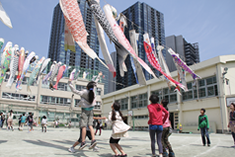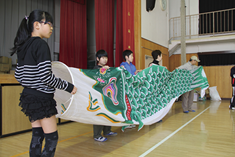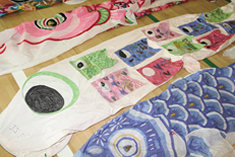Carp Streamers at Mitsugi Elementary School



Every year come the end of April and up to the beginning of May, over 130 colorful“ Koinoboris”, carp shaped streamers made of large pieces of cloth, gracefully swim the skies over Mitsugi Elementary School (3-16-28 Nishi-shinagawa).
This“ Koinobori streaming” is a traditional event which counts its 33rd event this year. It has been hosted by the PTA and alumni association of Mitsugi Elementary School since 1983, the school’s 60th anniversary year, with the support of local residents.
The event first started with only a few dozen Koinoboris, but has now grown to 139 carp as alumni, students, and other local residents donated Koinoboris they no longer hoist at their homes.
It is the mission of the 6th graders, the oldest children at the school, to hoist the Koinobori into the sky. With the help of the“ Chichioya-Club (Fathers’club)”, an organization made up of fathers of current students, the PTA, and the alumni association, children attach Koinoboris one by one to the three forty meter long ropes. By putting up the rope across the school yard, the carp
powerfully fly out into the sky.
There are very few places in central Tokyo, let alone within Shinagawa City, where so many Koinoboris can be seen swimming the skies at one location.
Koinoboris and the Tango Festival
May fifth is" Children's Day", one of Japan's national holidays with the purpose to "respect children's character, promote their happiness, and to thank mothers". Not only are Koinoboris hoisted for this festival, but there are customs to bathe in baths infused with a bundle of sweet flag, display Japanese armor and helmets or warrior dolls, and eat Chimaki
(rice dumpling wrapped in bamboo leaves) and Kashiwamochi (rice cake with bean paste wrapped in oak leaf).
May 5th in the old lunisolar calendar is a seasonal festival called the "Tango seasonal festival", marking the change of seasons according to a calendar originating from ancient China. In 6th century China, the Chinese are said to have picked medicinal herbs, decorated their homes with mugwort dolls and sweet flag to drive evil spirits away, and played dragon boat races for this festival. This festive tradition came over to Japan and has been taken into Japanese traditions. Bathing in sweet flag is most likely reminiscent of Chinese customs.
Starting in the Kamakura era (12th – 14th century), the festival became a seasonal festival to celebrate the growth of boys and to wish for their health. This originates from the fact that sweet flag leaves look like swords, and its phonetic sound, "shobu " being similar to a word that leads to valuing" budo" (martial arts) and" buyu" (military prowess).
Koinoboris are a custom that started in the Kanto region during the Edo era. It is said to have started amongst samurai warrior families and wealthy villagers who displayed streamers with carp drawings wishing for their child's healthy growth and social success based on a fable in which carp that swim up steep waterfalls become dragons.
Kashiwamochi , a rice cake with bean paste wrapped in oak leaf, is an original Japanese delicacy. Oak leafs don't fall until the next buds grow, and this being associated with" the family line continuing forever" has made Kashiwamochi a widely appreciated lucky item.
* Above is only one of the various stories explaining the origin of the festival.






